- Joined
- Jan 28, 2011
- Messages
- 97,507















https://felipepepe.medium.com/how-a-25-year-old-german-mmo-became-a-pokémon-fangame-6ac8d60c4442
How a 25-year-old German MMO became a Pokémon fangame
AKA Brazilians strikes again
When talking about the pioneer MMORPGs of the 90s — Meridian 59, Ultima Online, EverQuest, etc — there is a name that is often overlooked: Tibia, a German free-to-play MMO first released in 1997.
More than just curiosity or historical artefact, Tibia has one of the longest and most interesting stories among MMOs.
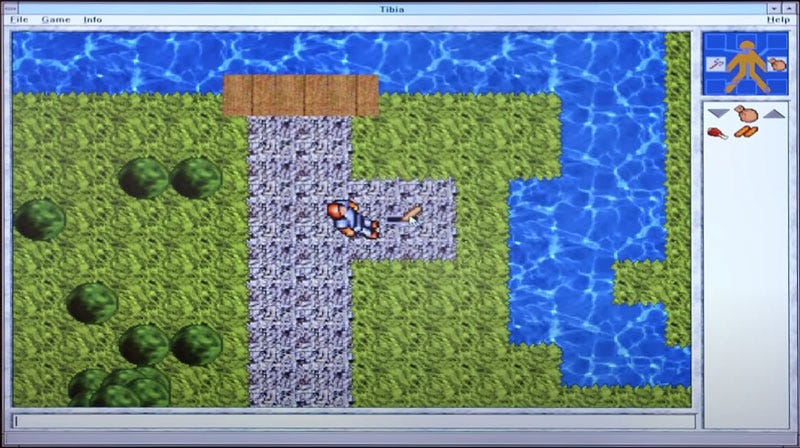
Tibia 1.0, from January 1997
The game was created by students at the University of Regensburg in Germany. In 1995 they began planning to develop something similar to MUDs (text-based online games), but with graphics and more elements from single-player RPGs:
“We were inspired by the Ultima series, especially Ultima VI and the possibility to interact with everything in the world of the game. Every item that was there could be taken and used — we wanted to combine that with the possibility to be on the move together with others in the game world.”
— Stephan Vogler, CipStudio’s Founder
Just like Ultima, Tibia has a very interactive world, allowing you to move objects around and combine them. Even on the very first version you could combine flour with milk and place it over the fire to bake cookies.
While Tibia would go online on January 7th, 1997 (predating MMOs like Ultima Online and Everquest), the truth is that this first version was an alpha release with barely any content. It would take six more months until enemies and NPCs were added, and only in May 1998 would classes, skills and spells be introduced.
The game ran on the university’s servers, and for a while, it was just a hobby project, with new content being added by volunteers such as Arndt Bednarzik, aka Knightmare:
“When I started Tibia it was quite different and 10 people online at once was ‘crowded’. I was active in the growing community and with the transition to a Tibia similar to that what you know I became one of the first gamemasters. When Cip (not Cipsoft by then) was looking for help to edit parts of their world I volunteered. The first version of the worldbuilding tool was incredibly clumsy and difficult. Many volunteers gave up without submitting anything significant. […] When Tibia turned from a student project into something commercial I, along with others, was tasked to supervise some of the gamemasters. All the while I continued to contribute content like areas and NPCs. When Tibia became more and more a success Cipsoft decided to hire employees for certain tasks and I was asked to join as the first content creator.” — Knightmare
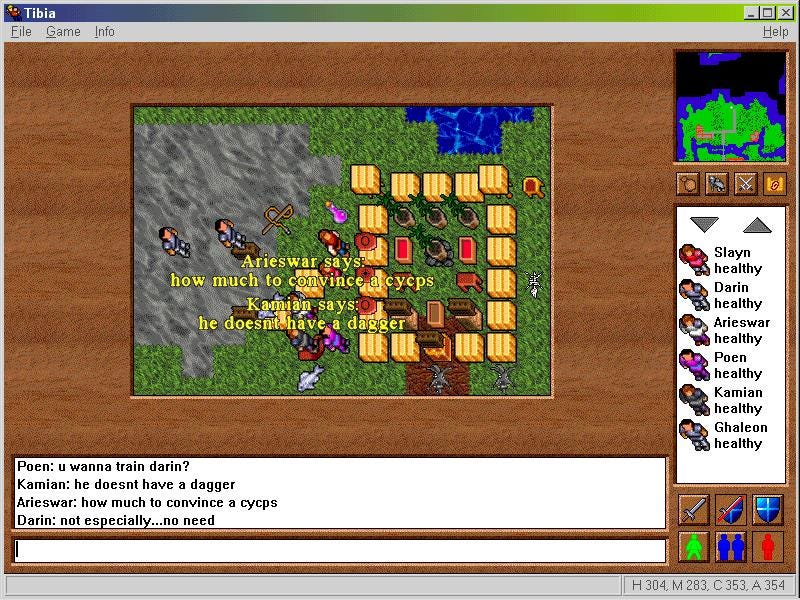
Tibia around 2000-2001
In 2001 the developers started their own company, CipSoft, and Tibia began to really grow into a professional MMO, played around the globe.
The game client was very small (about 4MB in 2001), meaning it could be downloaded even over very slow Internet connections. The controls and gameplay were also simple, and basic combat only required you to right-click on an enemy. And it could run on even the weakest computers.
“When the Internet Café I went to first started, the owner didn’t have money to invest on graphics cards. Only 2 of the 10 machines had graphics cards, so the business survived on people going there to copy documents and on Tibia players.” — William Oliveira
Above all, it was a free game, while other MMOs like EverQuest required you to buy the base game, multiple expansions, and then a monthly fee. All this combined to make Tibia an extremely accessible game.
In turn, it also led to some prejudice among gamers, as the game was seen as crude and simplistic, so primitive it didn’t even have sound (yes, Tibia didn’t have music or sound effects until 2022). “Go play Tibia” was used as an insult among hardcore gamers, just like “go play Candy Crush” or “go play Minecraft” would be years later.
Still, the game had features that would be considered quite hardcore today. For example, you needed to type incantations like “exevo flam hur” to cast spells, and type your dialogue when speaking with NPCs — saying “hi” to start talking then type keywords like “buy torch”, “sell rapier”, “dungeon”, “king”, etc. NPCs could only talk to one player at a time, leading to long lines in front of key NPCs.
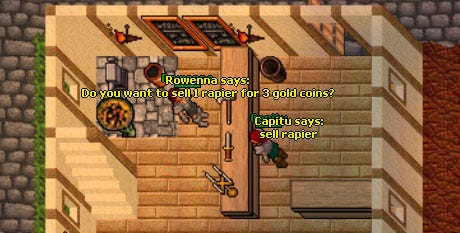
Originally designed for a few dozen players, Tibia is an MMO that feels closer to single-player games like Ultima or old-school JRPGs — it’s not as dependent on social interaction as Ultima Online, or on group battles as EverQuest.
The game’s quests were particularly well-designed for an MMO of the time: the Lighthouse Quest in the city of Thais had you find a book hinting at a secret dungeon. You had to locate the secret entrance, activated by a hidden switch, then cooperate with another player to activate pressure plates that unlock a teleporter. This teleporter leads to a room with two captive Cyclops, who protect a powerful warhammer and a shield. For context, this was in 1999, when the newly-released EverQuest only had quests like “bring me 5 wolf fangs”.
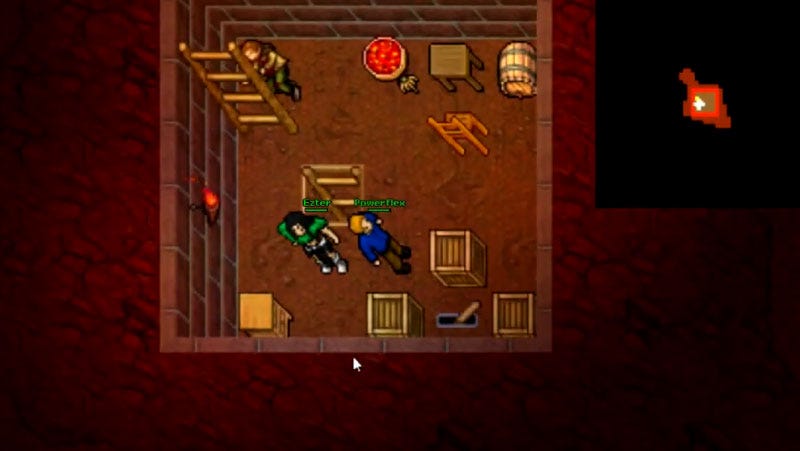
The switch for the secret entrance is hidden under a box.
However, this small-scale design led to issues dealing with its sudden spike in popularity in the 2000s. Its servers had no queue system, so when they were full players would spend several minutes repeatedly typing their login & passwords as fast as possible, trying to enter the server.
To monetize the game, a premium subscription was added later in 2001, offering an extensive list of benefits from bonus XP gain and faster HP regen to exclusive quests, areas, items, spells and in-game housing. More than half of the game’s cities are only accessible to premium players.
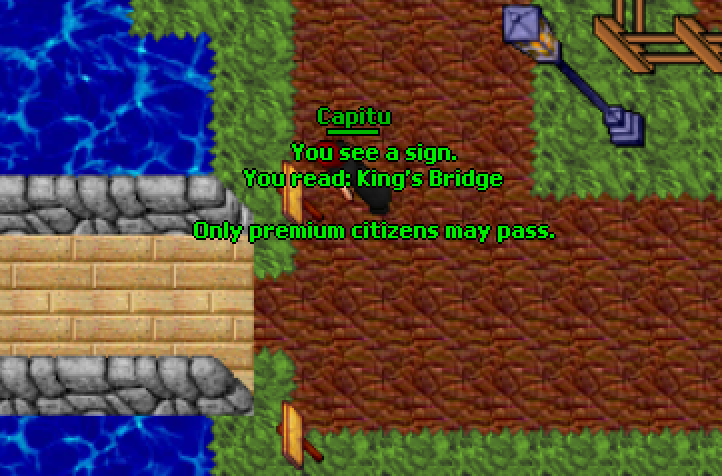
The very first area of the game, Rookgaard, was expanded with the infamous King’s Bridge, which only premium players could cross. It would lead into a special area with special shops, quests and dungeons, giving a headstart to premium players.
A new client and UI would be implemented in 2002, and Tibia would peak around 2007, with about 250,000 monthly active players. Some players complain that afterwards the game changed too much and lost its RPG roots, with CipSoft removing all GMs, streamlining the overall game experience and pushing too hard on the “pay-to-win” aspect.
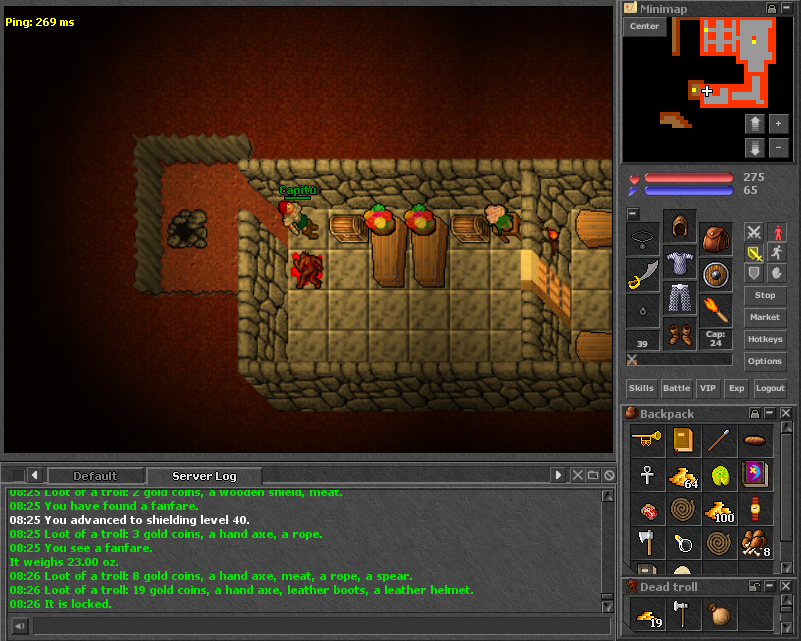
Tibia after the 2002 client update
Tibia is still ongoing, and it’s particularly popular among Brazilians and Polish players, who together make up more than half of the active players. In 2015, Cipsoft added a premium currency called Tibia Coins, which is purchased with real money but can also be exchanged back into money.
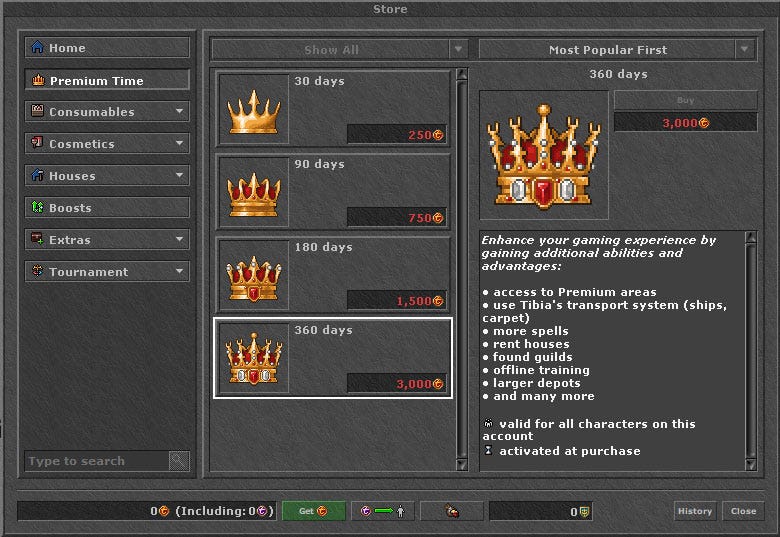
While item-selling always existed, the currency became a new venue for players seeking to profit. Mafia-like guilds began to appear, hunting and repeatedly killing characters unless they paid monthly protection fees in Tibia Coins. This in turn led to anti-extorsion guilds, and large-scale wars inside servers — some actually financed by real-world money.
One of such investors spent more than 50,000 Brazilian Reais (about 10,000 USD) over two months to finance his guild:
“It’s a hobby, right? People who go out to party also spend money. I work the entire day, while kids have lots of time. It was a way for me to help them, and then be able to play when I arrived home at night. […] I hired 20 Venezuelans to play. They earned more money than their parents, they were paid about 4 US dollars per hour. People think it’s absurd to spend so much money on this game, but you can get part of it back, there are items that are worth over 10,000 reais, if you control the server is easier to adquire these items.”
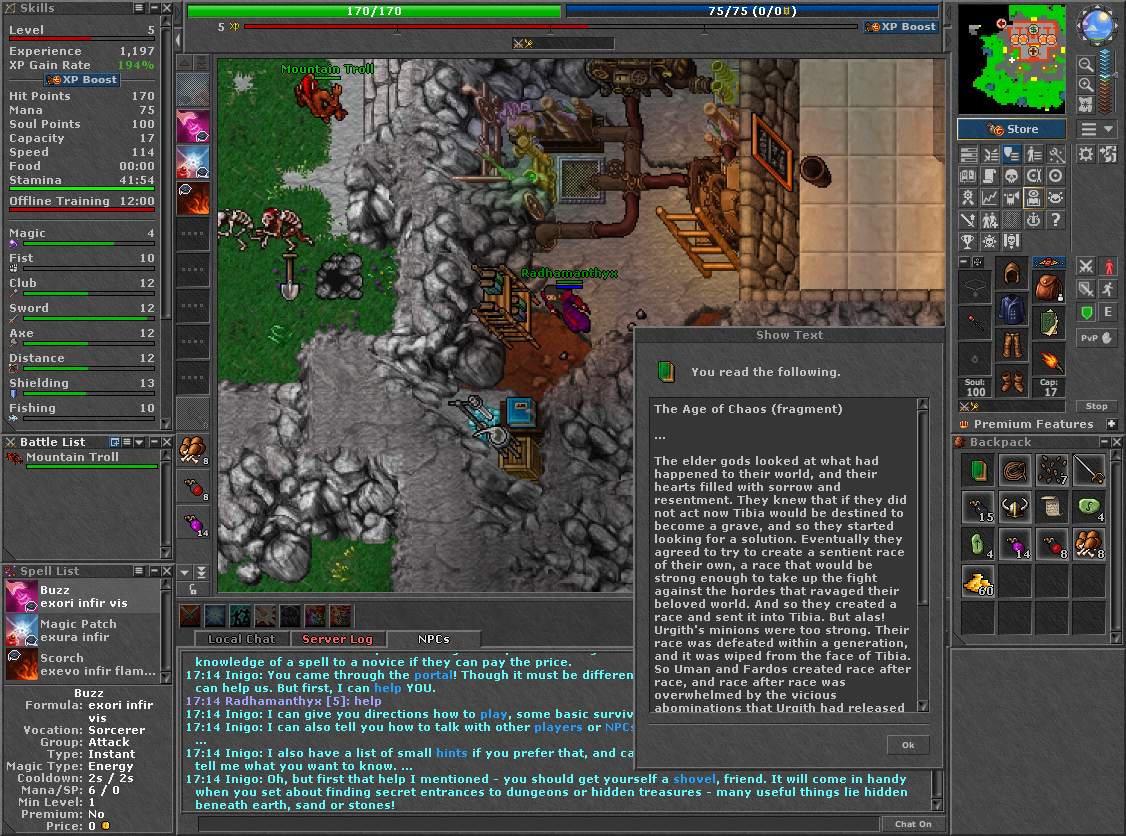
Tibia in 2022
Like any MMO, there are many other stories of iconic events across the game’s long history — the Sword of Fury that no one knows how to obtain, the mysterious door that only Lv 999 characters can cross, the Serpentine Tower puzzle people are still trying to solve, in-game weddings, guild wars, hacks, etc. A particularly bizarre one is Tibiaball: since the game allows players to push objects around, they began using the feature to play soccer tournaments… using the massive corpse of a bear:
The other half of Tibia’s history: Open Tibia
Everything so far is part of the official history of Tibia, the one developers are happily celebrating this year in the game’s 25th anniversary.
Still, Tibia’s biggest legacy might not be on its official servers, but rather on its offsprings: in 2001 a group of fans began reverse-engineering the game and creating an open-source client called OpenTibia. By 2004 the first private servers began appearing, led by Tibia Dark Age (TDA).
Over the years, the project evolved into several branches and was used to create thousands of servers. Some are ready-to-run packs that anyone can use to start their own classic Tibia server, others add new custom features or try to match the developments on the official servers. Even a mobile version was made, something the official Tibia does not support.

OTClientV8 on Android
To give a sense of the scale of Open Tibia servers, the otland.net forums were created in 2007 to gather people interested in the OT project. From 2007 to 2022 over 230,000 people registered in the forum and 10,000 OT servers were advertised on it.
According to OTserverlist.org, as of 2022, there are 495 servers in activity. Monitoring it over a week, the combined player count regularly goes over 20,000 online players, while the official Tibia servers peaks at 15,000 players. And some of the biggest OT servers block tracking to hide their numbers and avoid legal issues. So far more people play on OpenTibia servers than on official Tibia, despite both being free.
These OT servers come in all shapes and forms — some are simple recreations of the official servers but with increased XP rates, others add small changes like new classes and spells, and some offer entirely different experiences, such as capture the flag tournaments, PvP arenas, and recreations of famous series such as One Piece, Dragon Ball Z and Naruto (these are often called ATS — Alternative Tibia Servers).
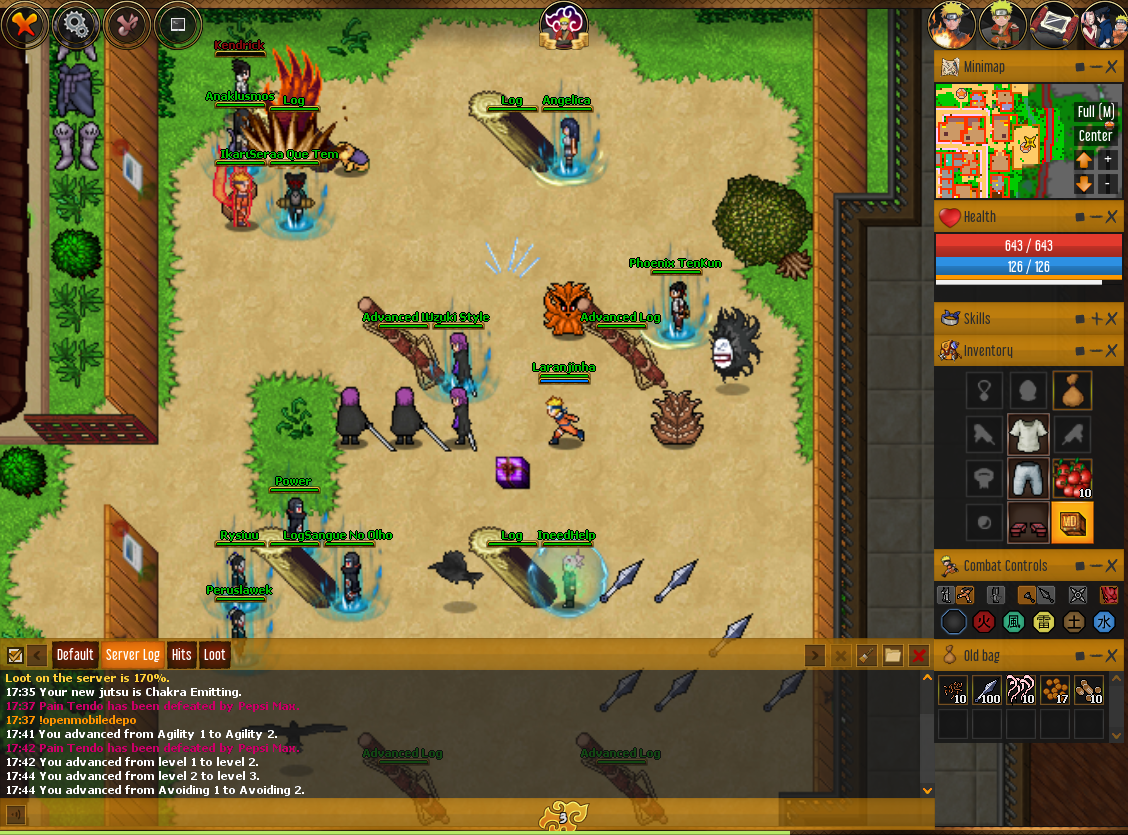
Naruto Story, based on Naruto.
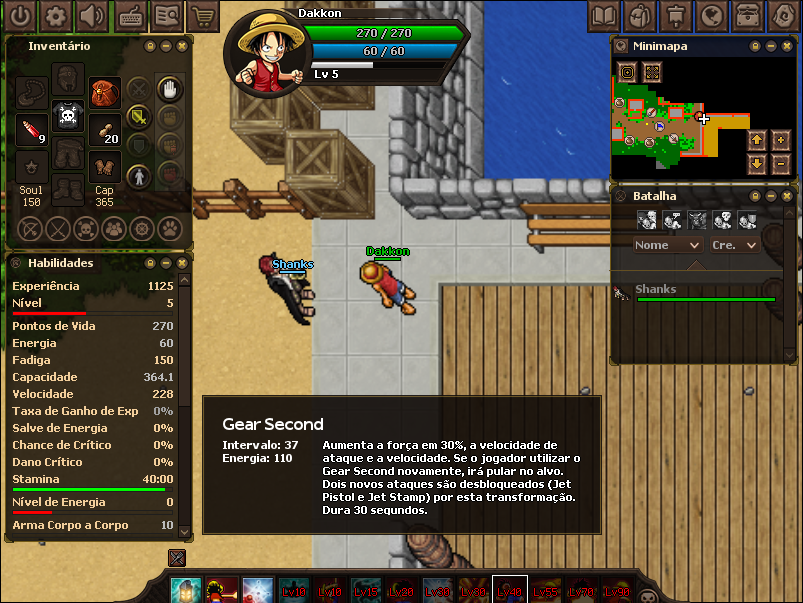
OtPiece, based on One Piece.
Some would last only a few days until the creator would give up — never visited by a single player — others would gather thousands of players over many years of activity.
Among these, the most famous today are the Pokémon servers. Also called PokéTibia, these servers began appearing in 2008, pioneered by a Brazilian project called Pokémon Online, created by SvkE (aka TuRtLe):
It contained the original 151 pokémons, allowing players to capture them, use them to battle across a large open world and even ride them. In many ways, it’s similar to what Nintendo would do years later with Pokémon Legends: Arceus. However, Pokémon Online was famous for being extremely difficult, requiring hundreds of hours of effort to capture the most powerful pokémons. The most hardcore players would parade across town with rare pokémons like Dragonite and Snorlax.

These servers follow a similar monetization system to Tibia, being free to play but having a monthly premium subscription that unlocked useful features, such as being able to fly on your pokémon or teleport across the world. This premium time could be purchased with real-world money and then traded with other players for in-game money or favours. Players who couldn’t afford the premium price would grind for weeks to make enough in-game money to buy a premium subscription, and then record videos and screenshots of them flying over the world with their rare pokémons.
One of the jobs that was created was the role of healer. They appeared because it was too expensive to buy potions to heal your pokémon while hunting, it would take a significant amount of money. So you would hire other players as healers, and when your pokémon was low on life they would heal them. The only pokémons that could heal were Wigglypuff, Chansey, Jigglypuff, Clefairy and Clefable, if I remenber correctly. As a reward, they would be paid 1,000 dollars [the in-game currency, not USD] per hour, and would get all the loot that other pokémons dropped — incluiding evolution stones, which were the rarest of all items. But it wasn’t really like that, usually if an evolution stone dropped people would hide it… I did that.” — InfoGames 67
The game grew to such popularity that it was running seven different servers by 2011 (OT servers support about 1,000 to 2,000 players) when it was hit by a Cease and Desist letter from Nintendo and had to close down. On the final three days before closing, the admins changed the rules to make everything easier and for more shiny pokémon to appear, creating a rush of people doing everything they wanted before the server went down.
Pokémon Online SvkE would soon be replaced by PokeXGames, which is still running as of 2022, now sporting 11 servers. Dozens of other PokéTibia would also appear and evolve over the years, adding new features such as improved UI, achievements and new pokémons.
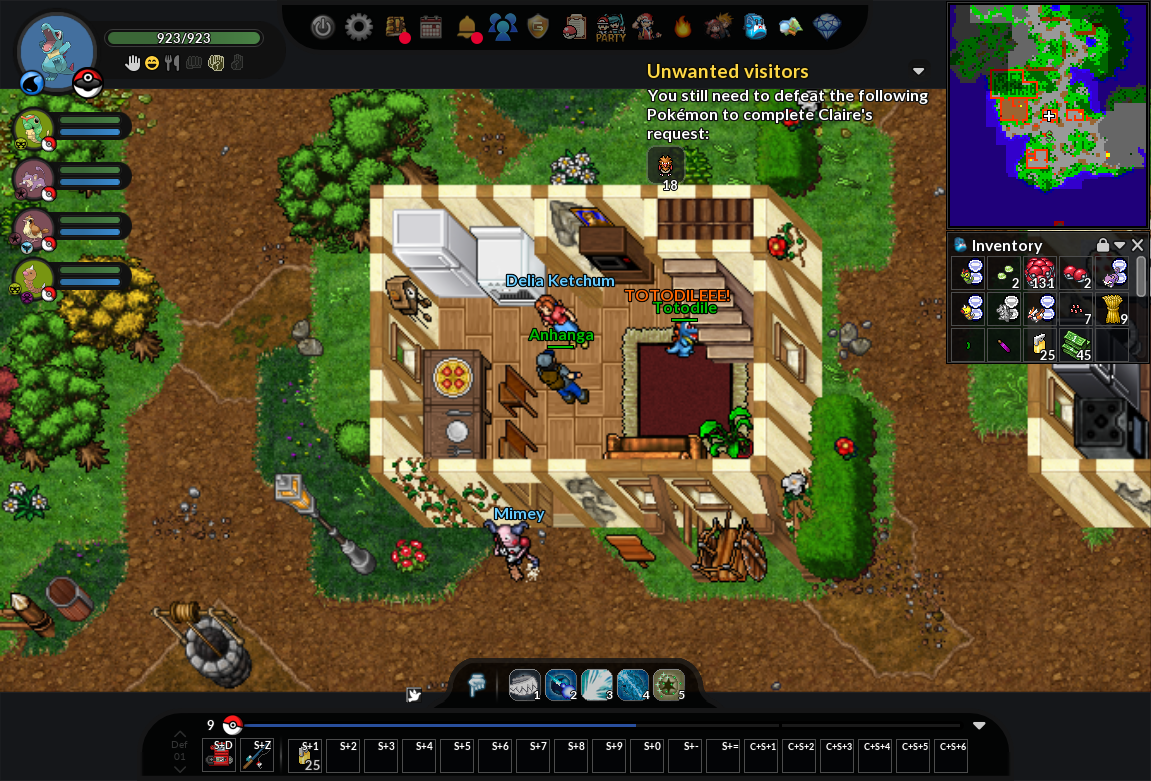
PokeXGames in 2022
In some ways, these games became more polished than the official Tibia. PxG is kept by a team of over 100 staff members and volunteers (Tibia has 59 staff members), almost all from Latin America or Poland. It has features such as a fully-voiced tutorial where Professor Oak guides new players through the game mechanics and first quests. Meanwhile, Tibia’s tutorial just asks you to choose a class and grind in a small area until level 8.
Moreover, while Tibia’s four classes are all combat-focused (Knight, Paladin, Druid & Sorcerer), PxG goes for a more diverse approach, offering four professions: Adventurer, Professor, Engineer and Stylist. While all can battle, the Adventurer is specialized in exploring, Engineer is focused on mining and crafting, the Professor can manage students who do tasks for him, and the Stylist makes money by crafting exclusive accessories for pokémon to wear:
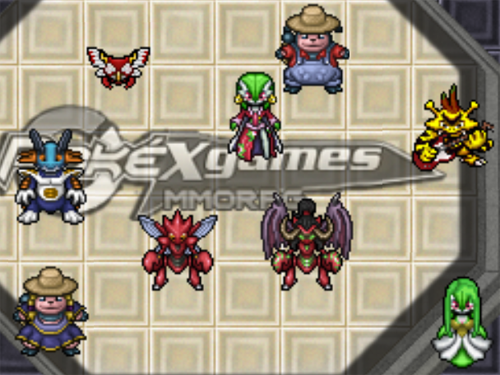
Your move, Fortnite.
While these servers are now a profitable commercial enterprise of dubious legality at best, they are also free, run on any computer, and are available in languages like English, Portuguese, Spanish and Polish (to date, not a single mainline Pokémon game was ever released in Portuguese or Polish).
It is not hard to see why they grew so popular over the last decade and might be the only Pokémon game some people ever played.










